Recently, the opportunity presented itself to transfer from a Microsoft Surface RT to a Surface Pro. While I very much enjoyed the Surface RT initially, over time I started to have some thoughts on pros and cons. Some of the major challenges the RT faced were in terms of server administration where a Hyper-V virtual machine was used for most admin tasks and I also ventured into RemoteApp for things like putty. The Microsoft Surface Pro changes the game completely. Also during the changeover I had the opportunity to swap my Touch Keyboard for a Type Keyboard for only $10. The Microsoft Store in Palo Alto was very nice after I showed them yet another keyboard with the cover defect. I was told it is a “one in a million” thing, then they realized it happened more than once to me. I did want to pen some initial thoughts prior to a longer term review.
Test Configuration
Here is the configuration I have been using heavily for a little over a week:
- Microsoft Surface Pro – 128GB
- Microsoft Type Cover for the Surface
- SanDisk Ultra (Class 10) 32GB Micro SDHC card with SD adapter
For those wondering, I do use the card slot all the time. I use the SD adapter to transfer to my PC and my Canon EOS Rebel T2i for the site’s photography. I did the same with the Microsoft Surface (RT.)
Initial Thoughts
I am going to break compatibility down into a few sections to organize the thoughts of transitioning from the Microsoft Surface to the Surface Pro. As a note – Microsoft did not provide samples so this may be a bit more independent than some of the reviews released just prior to the launch.
Migration to the Microsoft Surface Pro
Migrating to the Microsoft Surface Pro was very easy. On the Surface RT, the 32GB model is great just because there simply is not a lot of software available for the platform yet, especially large software packages for Windows RT. For media, a 64GB Micro SDHC card is around $55 and they are small enough that getting 128GB on those is about the same cost as going from 32GB to 64GB. The nice thing about the Surface RT is that you have that option plus a USB port. The Microsoft Surface Pro on the other hand, one really wants to the 128GB version. Whereas the Surface RT is going to be used more like an Apple iPad with Microsoft Office, the Surface Pro is a complete laptop replacement. With 128GB on the SSD for programs then 32-64GB for media and one is set. On the 64GB version, one can easily run into space issues.

The actual migration between the Surface RT and Surface Pro was very simple. With the Surface RT I had been using Microsoft Skydrive daily along with Synology DS1812+ NAS storage. Since programs are not cross compatible between Windows 8 and Windows RT, all one has to do is move documents. One USB 3.0 stick, swapping the SanDisk Micro SDHC card and connecting Skydrive and Synology and everything worked great! Using a Microsoft account for Office 2013 and Windows 8 meant that Skydrive documents showed up upon the initial launch of Microsoft PowerPoint and Excel. Total setup time was under 45 minutes including installing Office 2013, setting up iSCSI shares and etc. I will note, that I have stopped buying full SD cards at this point and have an armada of SD card adapters if I need to use a larger form factor as with the Canon.
Form Factor
The Microsoft Surface RT was awesome with the Type Cover because it was very thin and very light. The base Surface RT to Surface Pro swap added about 33% from around 1.5lbs to 2lbs on the main unit. That was a big enough jump that I acquiesced and got the Type Cover in store. The Type Cover is also large. What this means is that from a form factor perspective, the Surface Pro is large. Instead of the normal Surface RT to Surface Pro comparison, here is another data point: Microsoft Surface Pro with Type Cover to the Apple Macbook Air 11″ (Sandy Bridge Edition)
As one can see, the Macbook Air does sit thinner. Also with the front of the chassis being much thinner than the rear the overall feel is that the Macbook Air 11″ is much thinner than the Microsoft Surface Pro. Strangely enough, my initial conjecture was that side-by side that the Microsoft Surface Pro would end up being twice as thick as the Apple Macbook Air 11″. As it turns out, that is part of Apple’s magic. The Macbook Air feels thin while the Microsoft Surface Pro feels like a textbook (and note I am referring to my pre-law school text books here.)
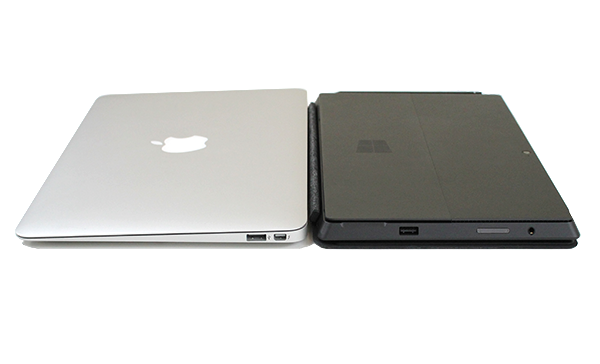
From the top, one can see the Microsoft Surface Pro is also quite a bit smaller than the Apple Macbook Air 11″.
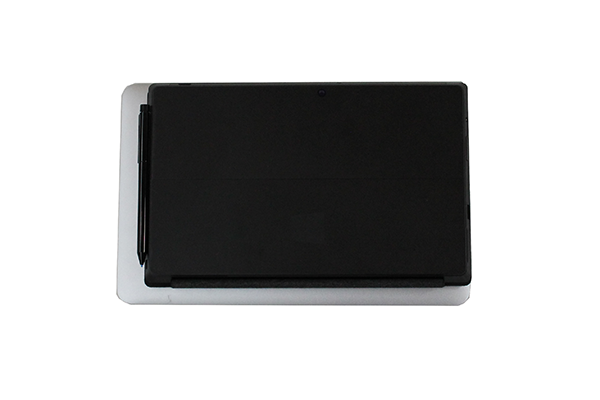
The Surface kick-stand remains, and in-store I played with every Atom and Core derived Windows 8 tablet and convertible. I still believe this is a feature more need to emulate.
Secret Weapon – The Microsoft Surface Pro Pen!
One item that came up in a few of the professional reviews was the ability to use the Microsoft Surface Pro pen. Technology for the digitizer was licensed from Wacom and is a derivative of their low-end product. After reading no less than a dozen reviews I saw sketch after sketch so I installed Autodesk’s sketch pad application. As it turns out, if one cannot draw on paper, moving to digital will not improve one’s fine motor skills. I will admit, I did flunk coloring in kindergarten (age 5 schooling for our international readers.) All of these reviews missed the absolute #1 killer application for the Microsoft Surface Pro: Office 2013. Office 2013 has an Ink feature which is nothing short of amazing!
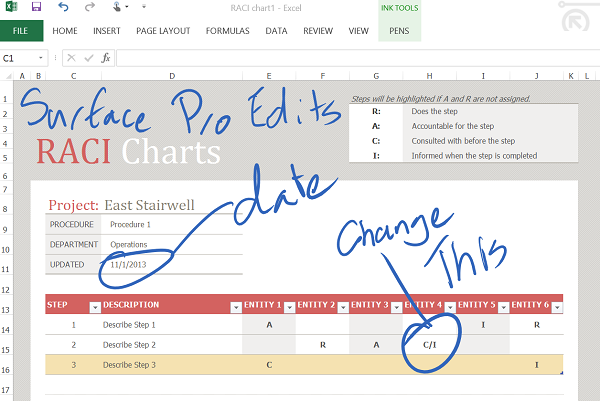
Associates beware – I can now hand write comments on not just Microsoft Word, and Microsoft PowerPoint, but also Microsoft Excel! Microsoft Word has excellent redlining features that we have used for years. With the Apple iPad we used a program extensively called Note Taker HD for years to markup Adobe PDFs and other documents. Now – we can take notes directly on Microsoft documents!
I did this recently giving a presentation. I was able to stand and take notes, with the pen on the Microsoft Surface Pro! I was also able to sketch out a slide we needed. Let’s put it this way, after showing folks around the office this discovery, jaws were dropping. Beyond this, Microsoft does have an input method where characters are recognized and added to the screen. It reminded me of the Apple Newton except that the technology is really good and one does not need to draw specific characters (again note my fine motor skill deficiency.)
Compatibility
Application compatibility is really good. There is only one application I have tried thus far with a major hurdle and that is Google Chrome. In Windows 8 Google Chrome runs full screen as a pseudo Windows 8 app. Chrome works great in this capacity. Where it falters is when one relaunches it in desktop mode and one cannot scroll using touch. According to the Google Product Forums this has been a known issue since October 2012.
Overall though, nothing much to report here, which in a sense is something to report. One can just run applications on the Microsoft Surface Pro as they would another Windows 8 machine. Everything just works. With the USB 3.0 drive, even picking up larger files like Access databases is fairly easily on the Surface Pro.
Miscellaneous
A few other thoughts. I confirmed in the forums that one can get Microsoft Hyper-V working on the Surface Pro. Practically speaking, one can now have a Hyper-V virtualization lab in a tablet format now. The screen is absolutely awesome compared to the Surface RT. The Microsoft Surface RT was “good enough” for most things, but the Microsoft Surface Pro is a direct laptop replacement.
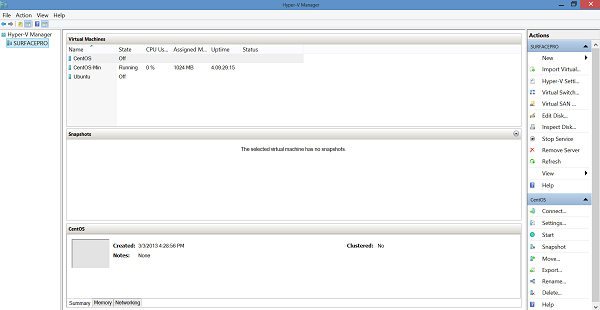
Let’s not forget, while the iPad does have a higher resolution, the Macbook Air 11″ is still only 1366 x 768. Price wise, the Surface Pro is about the same as the 11″ 128GB Macbook Air (since one needs at least one of the Surface covers.) In comparison though, the Macbook Air is sleek but feels like it has completely dated hardware. You can touch the Microsoft Surface Pro. You can draw and write on the Surface Pro. Apple needs a refresh of the Macbook Air 11″ line as soon as possible especially since I would guess it is a lot easier to integrate the Microsoft Surface Pro into existing enterprise IT architectures versus the Macbook Air devices which have become increasingly popular.
On battery life – not so good. This is not an all day present with me device. Too bad Microsoft couldn’t get Intel to push up Haswell for these. That may make the unit a bit cooler, but the current fan is really hard to hear and even playing games the Surface Pro is not that warm.
Conclusion
In a few weeks I will post a more formal review. With the Surface RT I was hooked on Windows touch computing but wanted the Surface Pro. This version is just about perfect, except I would really like 16GB of RAM and Haswell for better power consumption. Hopefully the next version will enable this for me. For now, I am happy that I have an awesome platform to use and present with.

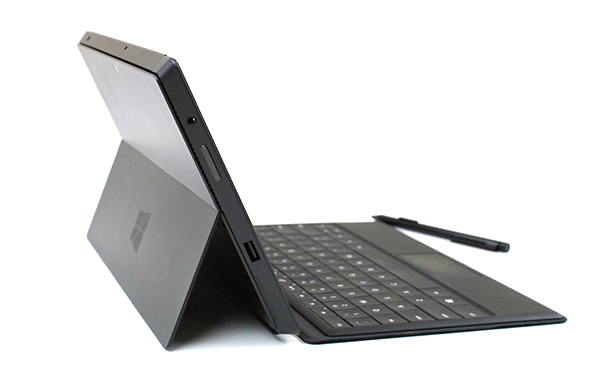
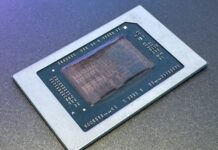

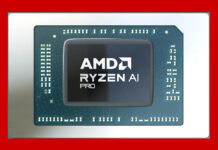
Been using a Samsung slate for almost a year now, took the plunge and upgraded to Win 8 recently, for the last year it’s been a dependable desktop replacement, the only downside is the resolution. How does the PRO holdup?
On the remote admin sessions though, I find remoting into a Server 2012 or Win 8 VM a right pain, trying to get the start screen to open on the VM with only the touchscreen….complete nightmare…..the only option is finding the pixel at the bottom left of the VM screen to open the start menu….otherwise if you press the windows key on you tablet, it just open the metro screen on the local machine……bloody annoying to say the least.
Adrian, try Alt-Home open the Start Menu in the Remote Desktop.
I use a program called StartIsBack on a few of my machines and Windows 8 virtual machines.
Thanks for the interesting perspective on the Pro. For me this is a “Buy Rev 2” kind of product. Once Haswell comes out the battery life issues should be solved (unless they lower the battery size to make it smaller….)
The only other thing I don’t like is that it is not “lapable” so to speak (can’t just set it up and use it direct on your lap like you can with a laptop or many of the other “covertable” style tablets).
If they offered an optional cover that would integrate this I would buy it in a heart beat.
Also one small typo:
“Macbook Air feels thing while the …..”
thing = thin
I’m not sure 16GB of ram is really necessary. 4GB can handle any high usage program available right now without any problems. 8GB can handle multiple. 16 is unnecessary at this point in time.
Nice review, sounds pretty accurate, and you didn’t whine about the battery life as if it’s the only thing that matters like all the other reviews.
Clearly, you don’t do any virtualization. 16GB would be the *minimum* RAM I’d accept in a laptop, 32GB being preferred. I couldn’t go back.
You can get away with 4GB, but I agree – 16GB is really the minimum I would like to see. Hyper-V works on these but you are looking at a very low memory VM since there is under 2GB available to guest operating systems.
Filled every need that my laptop was providing but at half the weight. Speed outstanding. Two solid days of using. ONLY complant are the diagonal edges, which felt they were cutting my fingers after 3 hours. None of the other tabs in this range had the very hard (sharp) edges all the way around. Others were rounded.
I’m buying more, but I hope MS revisits its design soon.Comfort is a major factor when you are holding this unit all day.
Great Article. I love my Surface Pro. Mine has developed a hairline crack in it, which I suspect is from it getting hot and then cooling off when off. This happened overnight. I used it heavily before bed and when I woke up, the battery was drained (like it didn’t go to sleep and ran a hung process). It was then I saw the small but worrysome hairline crack on the screen (think and as far across as a pinky nail.) I called Surface support twice and they said it would be $460 for a replacement (would replace with a totally new Surface Pro.) I think this is a design flaw from the heat and cooling. Any thoughts?
Brian – I was able to get an extended warranty on mine, purchased through the Surface online store. There is still a small fee to replace in store but ended up with a new box (so new pen and second power adapter): http://forums.servethehome.com/f14/microsoft-surface-pro-cracked-screen-odessy-1786.html
Hi , in the section of moving stuff from RT to Pro you also mentioned iSCSI shares. does that mean you actually had iSCSI running on the Surface RT tablet ?
and if so, could you elaborate on that ’cause I haven’t been able to get that working (keeps saying the iSCSI Initiator is missing)